NCERT Class 12 Physics Chapter 6 Notes, Electromagnetic Induction Class 12 Chapter 6 Notes
Have you ever considered the electricity lighting your house when a generator starts working, during a power cut, and thought about how a generator produces current without a battery? That's the beauty of Electromagnetic Induction, which is the essence of NCERT Class 12 Physics Chapter 6 Notes Electromagnetic Induction. This chapter illustrates how motion with magnetic fields (or, more generally, energy transfer) can produce electricity and, in fact, laid the very foundation for electricity generation in our modern world.
This Story also Contains
- NCERT Class 12 Physics Chapter 6 Notes: Download PDF
- NCERT Class 12 Physics Chapter 6 Notes: Electromagnetic Induction
- Electromagnetic Induction: Previous Year Question and Answer
- Importance of Electromagnetic Induction Class 12 Notes
- NCERT Class 12 Notes Chapterwise
- NCERT Books and Syllabus
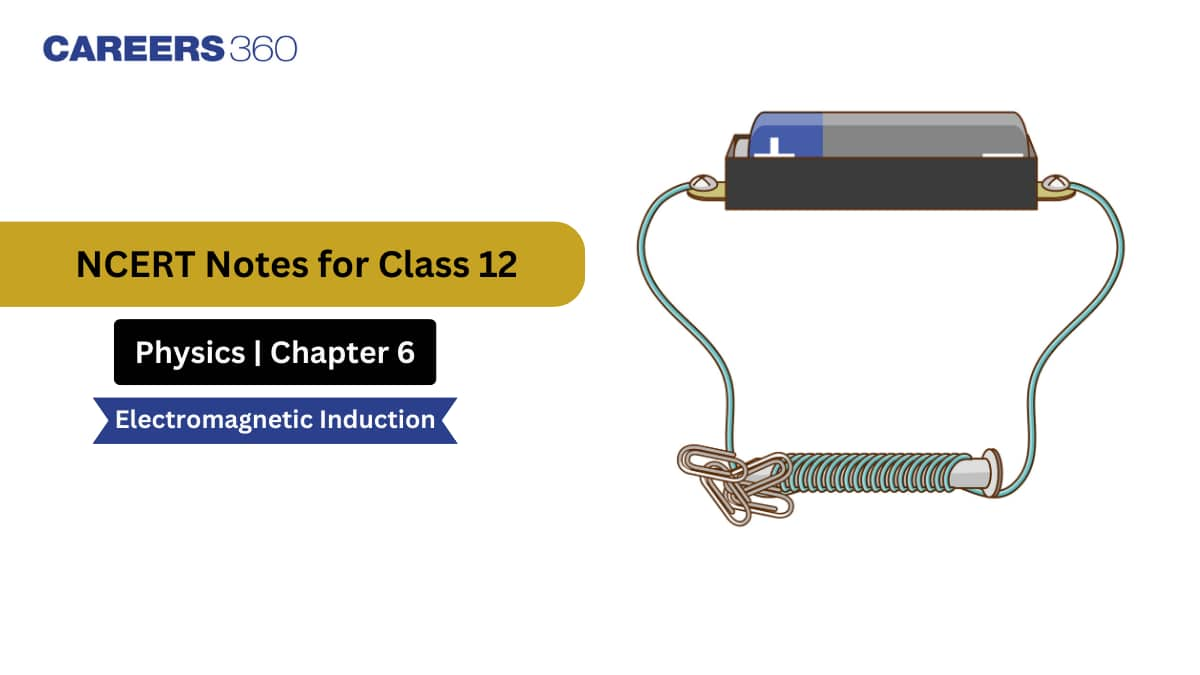
The NCERT Class 12 Physics Chapter 6 Notes Electromagnetic Induction PDF is central to anyone preparing for the CBSE board exams, JEE, and NEET, as it reinforces conceptual clarity and enhances numerical problem-solving capability. It also provides shorter notes for all the relevant topics, such as Faraday's Law of Induction, Lenz's Law, Magnetic Flux, Self-Inductance and Mutual Inductance, and AC Generators, in a logical and simple way. With diagrams that are easy and neat, formula sheets, illustrative solved examples, and references from past year questions, these notes help students revise quickly and efficiently. Whether students are reading for the first time or trying to brush up on their concepts before the exam, these notes act as their smart guide to mastering electromagnetic induction.
Also Read
NCERT Class 12 Physics Chapter 6 Notes: Download PDF
NCERT Class 12 Physics Chapter 6 Notes: Electromagnetic Induction offers a straightforward and systematic explanation for how electricity can be produced using motion and magnetic fields. The notes cover all the important concepts like Faraday’s laws, Lenz’s law, inductance, and AC generators, so these notes are great to use for a quick revision and to prepare for important exams such as the CBSE boards, but also competitive exams such as JEE and NEET. Students can easily download the PDF to have all the most important concepts in one place to strengthen their understanding.
NCERT Class 12 Physics Chapter 6 Notes: Electromagnetic Induction
Electromagnetic Induction Class 12 Notes explain how changing magnetic fields can produce electric current. These notes simplify key concepts like Faraday’s law, Lenz’s law, magnetic flux, and inductance, making them ideal for board exam preparation and competitive exams like JEE and NEET.
The experiments of Faraday and Henry
Faraday performed various experiments to discover and understand the phenomenon of electromagnetic induction. Some of them are :
- When the magnet is held stationary anywhere near or inside the coil, the galvanometer does not show any deflection.
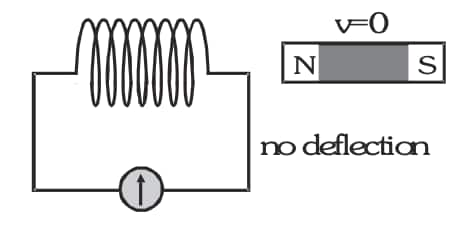
-
When the N-pole of a strong bar magnet is moved towards the coil, the galvanometer shows a deflection right to the zero mark.
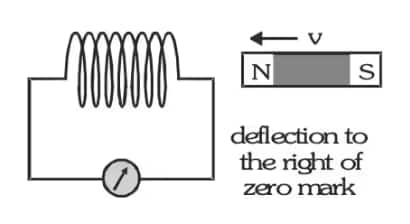
-
When the N-pole of a strong bar magnet is moved away from the coil, the galvanometer shows a deflection left to the zero mark.
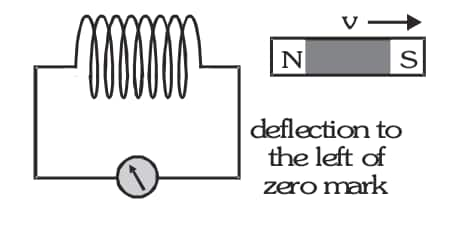
-
If the above experiments are repeated by bringing the S-pole of the magnet towards or away from the coil, the direction of current in the coil is opposite to that obtained in the case of the N-pole.
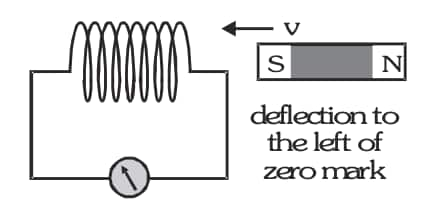
-
The deflection in the galvanometer is more when the magnet moves faster and less when the magnet moves more slowly.
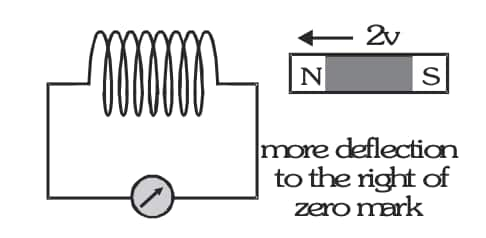
Magnetic Flux
The magnetic flux
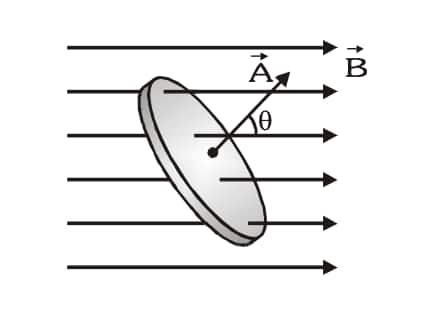
Note down the following points regarding the magnetic flux :
(i) Magnetic flux is a scalar quantity (the dot product of two vector quantities is a scalar quantity)
(ii) The SI unit of magnetic flux is tesla-metre
Thus, unit of magnetic field is also weber
or
- For a given area, flux will be maximum :
When the magnetic field
- For a given area flux will be minimum :
when magnetic field
Faraday’s Law of Induction
Based on his experimental studies on the phenomenon of electromagnetic induction, Faraday proposed the following two laws.
First law
Whenever the amount of magnetic flux linked with a closed circuit changes, an emf is induced in the circuit. The induced emf lasts so long as the change in magnetic flux continues.
Second law
The magnitude of the emf induced in a closed circuit is directly proportional to the rate of change of magnetic flux linked with the circuit. If the change in magnetic flux in a time dt is
Lenz's Law and Conservation of Energy
The negative sign in Faraday's equations of electromagnetic induction describes the direction in which the induced emf drives current around a circuit. However, that direction is most easily determined with the help of Lenz's law. This law states that:
"The direction of any magnetic induction effect is such as to oppose the cause of the effect."

This law is a direct consequence of the principle of conservation of energy. It ensures that energy is not created or destroyed in the process of electromagnetic induction.
Motional Electromotive Force
Let us consider a straight conductor moving in a uniform and time-independent magnetic field.
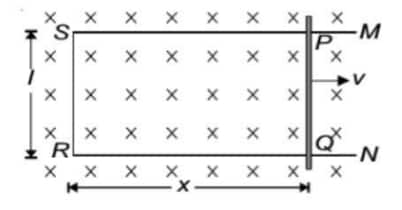
The figure shows a rectangular conductor MSRN upon which a conducting rod PQ moves (without friction) with constant velocity
The magnetic flux enclosed by the loop at
The rate of change of this magnetic flux will induce an emf given by
This emf, which is obtained due to the motion of the conductor instead of changing the magnetic field, is known as motional emf.
Inductance
Self-Inductance: When the current through the coil changes, the magnetic flux linked with the coil also changes. Due to this change of flux, a current is induced in the coil itself according to Lenz's concept it opposes the change in magnetic flux. This phenomenon is called self-induction, and a factor by virtue of the coil shows opposition to change in magnetic flux, called the coefficient of self-inductance of the coil.
Case - I Current through the coil is constant
If I
total flux of coil
where
Case - II Current through the coil changes w.r.t. time
Self-Inductance of a Solenoid
Let the cross-sectional area of solenoid=A, Current flowing through it=I
Length of the solenoid
then
But
If no iron or similar material is nearby, then the value of self-inductance depends only on the geometrical factors (length, cross-sectional area, number of turns).
Mutual Induction
Whenever the current passing through the primary coil or circuit changes, then the magnetic flux neighbouring secondary coil or circuit will also change. According to Lenz for the opposition to flux change so an emf induced in the neighbouring coil or circuit. This phenomenon is called 'Mutual induction'. In the case of mutual inductance for two coils situated close to each other
other, flux linked with the secondary due to the current in the primary.
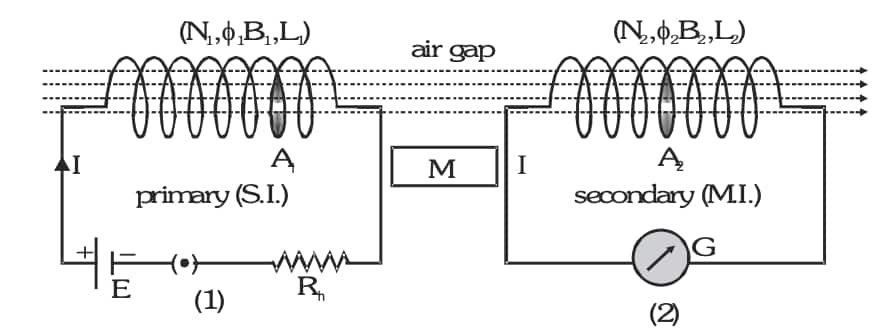
Case - I: When current through the primary is constant
The total flux of secondary is directly proportional to the current flow through the primary coil.
where M is the coefficient of mutual induction.
Case II: When the current through the primary changes with respect to time
where M is the coefficient of mutual induction.
Coefficient of coupling (K):
The coefficient of coupling of two coils is defined as
Energy stored in an inductor: The energy stored in an inductor is given by when a current I flows through it.
Magnetic energy is the form of energy stored in an inductor.
AC Generator
-
An electrical generator turns mechanical energy into electrical energy.
-
The phenomenon of electromagnetic induction is used to generate alternating currents (AC).
-
An emf is induced in the coil whenever the magnetic flux changes.
-
A device that converts mechanical energy into electrical energy is known as an AC generator (alternating current).
-
By altering the magnetic field and area vector, an AC generator can induce an emf or current in a loop.
Principle:-
-
A change in the loop's orientation or effective area causes current to flow through it.
-
Modifying the area vector or changing the induced emf produces an induced emf.
-
Fleming's right-hand rule determines the direction of the current.
-
The up and down movement of the loops changes the direction of the current in the circuit.
It is based on the phenomenon of electromagnetic induction asserts that whenever the magnetic flux associated with a conductor (or coil) changes, an emf is induced in the coil.
If E is the induced emf in the coil, then
E0=NBAω is the induced EMF's maximum or peak value.
Electromagnetic Induction: Previous Year Question and Answer
Q1: The self-inductance L of a solenoid of length l and area of cross-section A, with a fixed number of turns N, increases as
(A) l and A increase.
(B) l decreases and A increases.
(C) l increases and A decreases.
(D) both l and A decrease.
Answer:
The formula for the self-inductance of a solenoid is given by:
So, from the equation, the inductance should increase as I decrease and
Hence, the answer is option (B).
Q2: The number of turns of a solenoid is doubled without changing its length and area of cross-section. The self-inductance of the solenoid will become ___________ times.
(A)4
(B) 2
(C) 6
(D) 3
Answer :
The area and length are not changed. Therefore
Therefore, when the number of turns of a solenoid is doubled, the inductance will become 4 times.
Hence, the answer is the option (1).
Q3: Define the self-inductance of a coil. Obtain the expression for the energy stored in an inductor L connected across a source of emf.
Answer :
Self-induction: Induction of emf in a coil due to a change in current in the same coil.
Where L is known as the coefficient of self-induction or self-inductance.
Consider an inductor connected across an emf E. For current
The amount of work done in establishing the current I is
Importance of Electromagnetic Induction Class 12 Notes
Foundation for Electricity Production
- Everyone should understand electromagnetic induction, as it is the principle behind the generation of electricity in power stations with AC and DC generators.
Important Topic for Competitive Exams
- This chapter is important, as it forms a basic part of the CBSE Class 12 Physics syllabus and is frequently asked in JEE and NEET.
Understanding Magnetic Effects of Current
- It helps in grasping how changing magnetic fields induce currents, which is essential for studying transformers, inductors, and modern electrical devices.
Problem-Solving Practice
- Mastering the use of formulas and laws like Faraday's law of induction and Lenz's law also helps create problem-solving strategies for numerical and theoretical questioning.
Real-Life Applications
- Furthermore, this chapter teaches the functionality of everyday devices such as electric motors, transformers, induction cookers, and MRI machines, and it connects how we understand electrodynamics to already available modern technology.
Conceptual Clarity
- This chapter applies to your understanding of flux, self-induction, mutual induction, and energy stored in a magnetic field, all knowledge that is key to higher studies in Physics.
Step Towards Advanced Topics
- Electromagnetic induction also serves as a good jumping-off point into topics such as AC circuits, electromagnetic waves, and modern physics subjects with poorly understood phenomena.
NCERT Class 12 Notes Chapterwise
Class 12 Physics chapter-wise notes from NCERT provide you with a lot of structure and cover all the topics in the syllabus. These chapter-wise notes simplify difficult concepts and are rich in important formulas, diagrams, and solved examples. They are very good for board exam preparation as well as for competitive exams such as JEE and NEET. Students can use these chapter-wise notes to facilitate quick revision work, improve understanding of Physics concepts and solve problems faster.
|
NCERT Class 12 Physics Chapter 6 Notes |
Subject-Wise NCERT Exemplar Solutions
Subject Wise NCERT Solutions
NCERT Books and Syllabus
Frequently Asked Questions (FAQs)
Faraday’s Law of Electromagnetic Induction
The First Law
When the magnetic flux in a closed-loop or circuit varies, an emf is generated in the loop or circuit that lasts as long as the flux is changing.
Second Law
The rate of change of magnetic flux in a closed-loop or circuit is directly proportional to the induced emf in the closed-loop or circuit.
Focus on Faraday’s Laws, Lenz’s Law, Motional EMF, Inductance (self & mutual), AC Generator, and Eddy Currents.
Yes, derivations like EMF induced in a moving rod, self-inductance of a coil, and AC generator working are frequently asked.
It is used in electric generators, transformers, induction motors, wireless charging, and many other electrical devices.
Lenz’s Law states that the direction of the induced current is such that it opposes the change in magnetic flux that caused it.
Popular Questions
Courses After 12th
Applications for Admissions are open.
As per latest syllabus. Physics formulas, equations, & laws of class 11 & 12th chapters
JEE Main Important Chemistry formulas
Get nowAs per latest syllabus. Chemistry formulas, equations, & laws of class 11 & 12th chapters
JEE Main high scoring chapters and topics
Get nowAs per latest 2024 syllabus. Study 40% syllabus and score upto 100% marks in JEE
JEE Main Important Mathematics Formulas
Get nowAs per latest syllabus. Maths formulas, equations, & theorems of class 11 & 12th chapters
